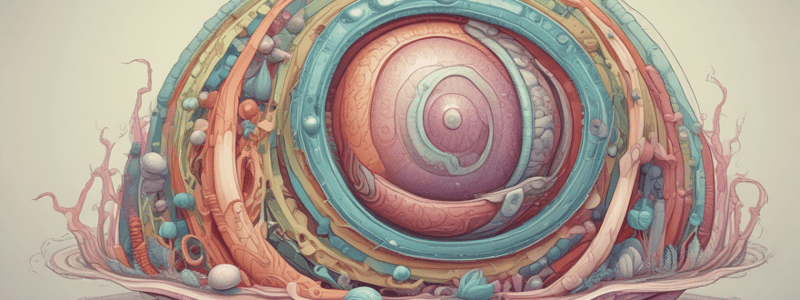Podcast
Questions and Answers
What is the term used to describe the process of formation of the three germ layers?
What is the term used to describe the process of formation of the three germ layers?
- Organogenesis
- Morphogenesis
- Neurulation
- Gastrulation (correct)
Which of the following is NOT a supportive structure formed from the major portion of the egg cell mass?
Which of the following is NOT a supportive structure formed from the major portion of the egg cell mass?
- Placenta
- Extraembryonic membranes
- Embryo (correct)
- Amniotic sac
What is the purpose of the notochord?
What is the purpose of the notochord?
- Formation of the neural tube
- Formation of the vertebral column (correct)
- Formation of the digestive system
- All of the above
What is the term used to describe the solid cord formed from the prenotochordal cells?
What is the term used to describe the solid cord formed from the prenotochordal cells?
Which of the following is the middle germ layer?
Which of the following is the middle germ layer?
What is the function of the epiblast cells?
What is the function of the epiblast cells?
What is the term used to describe the depression that appears in the center of the primitive knot?
What is the term used to describe the depression that appears in the center of the primitive knot?
What is the result of abnormal developmental alterations during germ layer formation?
What is the result of abnormal developmental alterations during germ layer formation?
What forms the neural plate?
What forms the neural plate?
Which of the following cells is NOT derived from neural crest cells?
Which of the following cells is NOT derived from neural crest cells?
What is essential for the normal growth of the head and neck region?
What is essential for the normal growth of the head and neck region?
What forms between the pharyngeal arches?
What forms between the pharyngeal arches?
What contributes to the development of the face and neck?
What contributes to the development of the face and neck?
What develops from the ectoderm?
What develops from the ectoderm?
Which of the following muscles are derived from the first pharyngeal arch?
Which of the following muscles are derived from the first pharyngeal arch?
Which nerve supplies the muscles of mastication?
Which nerve supplies the muscles of mastication?
What is the blood supply of the derivatives of the third pharyngeal arch?
What is the blood supply of the derivatives of the third pharyngeal arch?
Which of the following cartilages are derived from the second pharyngeal arch?
Which of the following cartilages are derived from the second pharyngeal arch?
Which muscle is derived from the third pharyngeal arch?
Which muscle is derived from the third pharyngeal arch?
Which nerve supplies the derivatives of the fourth and sixth pharyngeal arches?
Which nerve supplies the derivatives of the fourth and sixth pharyngeal arches?
Flashcards are hidden until you start studying
Study Notes
Formation of Germ Layers
- After fertilization, the ovum undergoes cell divisions, forming a mass called the morula in mammals
- The inner cell mass (embryoblast) separates into two layers: the epiblast and hypoblast
- The epiblast forms the embryo, while the hypoblast and other cells form supporting structures like the placenta
- Gastrulation is the process of forming the three germ layers: endoderm, mesoderm, and ectoderm
Formation of Primitive Streak and Germ Layers
- The epiblast cells divide and move through the primitive streak, replacing the hypoblast cells to form endoderm
- The cells remaining between the epiblast and endoderm form the mesoderm
- The cells remaining in the epiblast form the ectoderm, completing the formation of the three germ layers
Notocord Formation
- A depression in the center of the primitive knot forms a blastopore
- Prenotochordal cells pass cranially in the midline between the ectoderm and endoderm, forming a solid cord called the notochordal process
- The notochord provides a scaffold for neural tube formation and eventually becomes the vertebral column
Neural Tube Formation
- The ectoderm overlying the notochord thickens, forming the neural plate
- The neural plate undergoes a slipper-shaped thickening, forming neural folds
- The neural folds eventually form the neural tube
Neural Crest Cells
- Neural crest cells are multipotent cells that give rise to various cells, including odontoblasts, melanocytes, ganglia, and more
- The neural crest cells migrate to form the enamel organ, ectomesenchyme, and other structures in the head and neck region
Development of Pharyngeal Arches
- The gradual appearance of pharyngeal (branchial) arches contributes to the development of the face and neck
- Each arch has a skeletal element, artery, muscles, and nerve supply
- Ectodermal clefts and endodermal pouches between the arches give rise to various structures
Derivatives of Pharyngeal Arches
- First arch (mandibular arch): muscles of mastication, mylohyoid, anterior belly of digastric, Meckel's cartilage, and more
- Second arch (hyoid arch): muscles of facial expression, posterior belly of digastric, Reichert's cartilage, and more
- Third arch: stylopharyngeus muscle, greater horn and lower part of body of hyoid bone, common carotid artery, and glossopharyngeal nerve
- Fourth and sixth arches: crico-thyroid muscle, levator palatine, constrictor of pharynx, and more
Studying That Suits You
Use AI to generate personalized quizzes and flashcards to suit your learning preferences.




